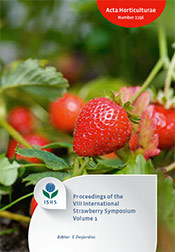Ver ítem
- xmlui.general.dspace_homeCentros e Institutos de InvestigaciónCIAP. Centro de Investigaciones AgropecuariasInstituto de Patología VegetalArtículos científicosxmlui.ArtifactBrowser.ItemViewer.trail
- Inicio
- Centros e Institutos de Investigación
- CIAP. Centro de Investigaciones Agropecuarias
- Instituto de Patología Vegetal
- Artículos científicos
- Ver ítem
Advances in characterization and epidemiology of strawberry viruses and phytoplasmas in Argentina
Resumen
The presence of systemic pathogens, such as viruses and phytoplasmas, in strawberry plants is the usual situation worldwide. More than 20 virus species and 6 phytoplasmas 16Sr groups have been cited infecting strawberries in different countries. Petiole-insert leaflet grafting to strawberry virus indicator plants Fragaria vesca var. semperflorens (Duch.) 'Alpine', F. vesca 'UC5' and F. virginiana 'UC12', has allowed detecting the presence of virus in
[ver mas...]
The presence of systemic pathogens, such as viruses and phytoplasmas, in strawberry plants is the usual situation worldwide. More than 20 virus species and 6 phytoplasmas 16Sr groups have been cited infecting strawberries in different countries. Petiole-insert leaflet grafting to strawberry virus indicator plants Fragaria vesca var. semperflorens (Duch.) 'Alpine', F. vesca 'UC5' and F. virginiana 'UC12', has allowed detecting the presence of virus in strawberry plants collected from commercial farms in several locations of Argentina. Strawberry mild yellow edge virus (SMYEV), Strawberry mottle virus (SMoV), Strawberry crinkle virus (SCV) and Strawberry polerovirus 1 (SPV1) have been identified and characterized using reverse transcription polymerase chain reaction (RT-PCR) with specific primers and sequencing parts, or complete genome of the viruses. These viruses have been detected in different producing regions, in simple or mixed infections. In parallel, numerous species of aphids (virus vectors), such as Aphis forbesi Weed, A. gossypii Glover, Chaetosiphon fragaefolii (Cockerell), C. minor (Forbes), C. thomasi Hille Ris Lambers, Macrosiphum euphorbiae (Thomas) and Myzus persicae (Sulzer), have also been found. Two different phytoplasmas have been detected in strawberry in Argentina up to now. Argentinean Strawberry Phyllody (ASP) and Strawberry red leaf (StrawRL) phytoplasmas. The Instituto Nacional de Tecnologia Agropecuaria (INTA) from Argentina has implemented a pathogen-free plants production program, where plants are obtained by meristem culture in vitro, and then they are transferred to ex vitro conditions to the screenhouses under controlled environmental conditions. All the plants obtained are tested for virus and phytoplasm by grafting to indicator plants, RT-PCR with specific primer for viruses and PCR for phytoplasmas. The plants with negative results to the tests performed are propagated in a greater scale in isolated area (nurseries). This methodology allows not only increasing fruit yield but also contributes to prevent pathogen dispersion
[Cerrar]

Autor
Conci, Vilma Cecilia;
Luciani, Cecilia Elizabeth;
Merino, M.C.;
Celli, Marcos Giovani;
Perotto, Maria Cecilia;
Torrico Ramallo, Ada Karina;
Pozzi, Elizabeth Alicia;
Strumia, Gisella;
Dughetti, Arturo Carlos;
Asinari, Florencia;
Conci, Luis Rogelio;
Fernandez, Franco Daniel;
Salazar, Sergio Miguel;
Meneguzzi, Natalia;
Kirschbaum, Daniel Santiago;
Fuente
Acta horticulturae 1156 : 801-810. (April 2017)
Fecha
2017-04
ISSN
0567-7572
Formato
pdf
Tipo de documento
artículo
Palabras Claves
Derechos de acceso
Restringido
 Excepto donde se diga explicitamente, este item se publica bajo la siguiente descripción: Creative Commons Attribution-NonCommercial-ShareAlike 2.5 Unported (CC BY-NC-SA 2.5)
Excepto donde se diga explicitamente, este item se publica bajo la siguiente descripción: Creative Commons Attribution-NonCommercial-ShareAlike 2.5 Unported (CC BY-NC-SA 2.5)

